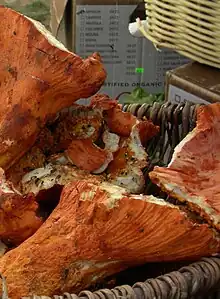| Lobster mushroom | |
|---|---|
 | |
| Scientific classification | |
| Domain: | Eukaryota |
| Kingdom: | Fungi |
| Division: | Ascomycota |
| Class: | Sordariomycetes |
| Order: | Hypocreales |
| Family: | Hypocreaceae |
| Genus: | Hypomyces |
| Species: | H. lactifluorum |
| Binomial name | |
| Hypomyces lactifluorum | |
Hypomyces lactifluorum, the lobster mushroom, contrary to its common name, is neither a mushroom nor a crustacean, but rather a parasitic ascomycete fungus that grows on certain species of mushrooms, turning them a reddish orange color[1] that resembles the outer shell of a cooked lobster. H. lactifluorum specifically attacks members of the genera Lactarius and Lactifluus (milk-caps), and Russula (brittlegills), such as Russula brevipes and Lactifluus piperatus in North America. At maturity, H. lactifluorum thoroughly covers its host, rendering it unidentifiable. Lobster mushrooms are widely eaten and enjoyed freshly foraged and cooked.[2] They are commercially marketed and sometimes found in grocery stores; they have been made available at markets in Oregon.[2] They have a seafood-like flavor and a firm, dense texture.
A study from Quebec found that the infected lobster mushroom mostly contains the DNA of the parasitic fungus with only trace amounts of Russula brevipes DNA. This study also measured intermediate products of chemical reactions, or metabolites, in infected and non-infected mushrooms. Metabolites help determine how fungi look and taste, and whether they are fit to eat. They found that through the course of its infection, the parasitic fungus completely alters the diversity and amount of metabolites in Russula brevipes.[3]
While edible, field guides note the hypothetical possibility that H. lactifluorum could parasitize a toxic host and that individuals should avoid consuming lobster mushrooms with unknown hosts, although no instances of toxicity have been recorded.[2][4][5] During the course of infection, the chemicals get converted into other more flavorful compounds, making lobster mushrooms more edible. Lactarius piperatus has a spicy, hot flavor but that flavor is counteracted by the parasite H. lactifluorum, making it more edible and delicious.[6] One author notes that he has personally never experienced any trouble from consuming them[2] and another notes that there have been no reports of poisoning in hundreds of years of consumption.[5] White, pink and yellow molds could be toxic lookalike species.[7]
Similar species include Hypomyces cervinigenus, H. chrysospermus, and H. luteovirens.[1]
References
- 1 2 Davis, R. Michael; Sommer, Robert; Menge, John A. (2012). Field Guide to Mushrooms of Western North America. Berkeley: University of California Press. pp. 382–383. ISBN 978-0-520-95360-4. OCLC 797915861. Archived from the original on 2022-06-03. Retrieved 2022-10-08.
- 1 2 3 4 Meuninck, Jim (2017). Foraging Mushrooms Oregon: Finding, Identifying, and Preparing Edible Wild Mushrooms. Falcon Guides. p. 16. ISBN 978-1-4930-2669-2.
- ↑ "A taste of the wild—Deciphering the lobster mushroom". Canadian Science Publishing. Archived from the original on 2021-07-12. Retrieved 2021-05-04.
- ↑ Phillips, Roger (2010). Mushrooms and Other Fungi of North America. Buffalo, NY: Firefly Books. p. 379. ISBN 978-1-55407-651-2.
- 1 2 McFarland, Roger; Mueller, Gregory M. (2009). Edible Wild Mushrooms of Illinois and Surrounding States: A Field-to-Kitchen Guide (Field-To-Kitchen Guides). Urbana: University of Illinois Press. pp. 71–72. ISBN 978-0252076435.
- ↑ "Hypomyces lactifluorum, the lobster mushroom, Tom Volk's Fungus of the Month for August 2001". botit.botany.wisc.edu. Archived from the original on 2021-05-04. Retrieved 2021-05-04.
- ↑ Davis, R. Michael; Sommer, Robert; Menge, John A. (2012). Field Guide to Mushrooms of Western North America. Berkeley: University of California Press. p. 29. ISBN 978-0-520-95360-4. OCLC 797915861. Archived from the original on 2022-06-03. Retrieved 2022-10-08.
External links
 Media related to Hypomyces lactifluorum at Wikimedia Commons
Media related to Hypomyces lactifluorum at Wikimedia Commons- A lobster mushroom article on Tom's Fungi
- AmericanMushrooms.com: Lobster Mushroom
- Lobster mushroom on mykoweb